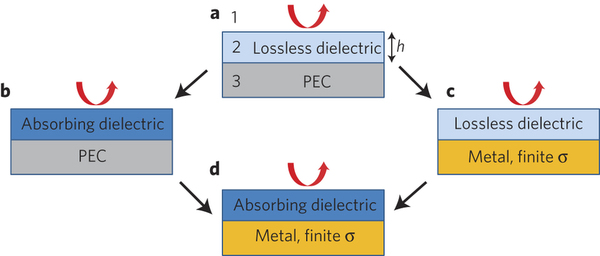"Nanometre optical coatings based on strong interference effects in highly absorbing media". M. A. Kats, R. Blanchard, P. Genevet, F. Capasso. NATURE MATERIALS. In press. DOI: 10.1038/nmat3443
Optical coatings, which consist of one or more films of dielectric or
metallic materials, are widely used in applications ranging from mirrors
to eyeglasses and photography lenses.
Many conventional dielectric coatings rely on Fabry–Perot-type
interference, involving multiple optical passes through transparent
layers with thicknesses of the order of the wavelength to achieve
functionalities such as anti-reflection, high-reflection and dichroism.
Highly absorbing dielectrics are typically not used because it is
generally accepted that light propagation through such media destroys
interference effects. We show that under appropriate conditions
interference can instead persist in ultrathin, highly absorbing films of
a few to tens of nanometres in thickness, and demonstrate a new type of
optical coating comprising such a film on a metallic substrate, which
selectively absorbs various frequency ranges of the incident light.
These coatings have a low sensitivity to the angle of incidence and
require minimal amounts of absorbing material that can be as thin as
5–20 nm for visible light. This technology has the potential for a
variety of applications from ultrathin photodetectors and solar cells to
optical filters, to labelling, and even the visual arts and jewellery.
Los recubrimientos ópticos que consisten de una o más películas de materiales dieléctricos o metálicos son ampliamente usados en aplicaciones que van desde espejos hasta anteojos y lentes fotográficas. Muchos de los recubrimientos dieléctricos convencionales se basan en una interferencia tipo Fabry-Perot, que involucra la transmisión óptica a través de múltiples capas transparentes, la cuales tienen un espesor del orden de la longitud de onda para lograr funcionalidades tales como antireflejo, dicroísmo y alta reflectividad. Los dieléctricos altamente absorbentes típicamente no son empleados porque generalmente se cree que la propagación de luz a través de dichos medios destruye los efectos de interferencia. En cambio, se muestra que bajo condiciones apropiadas, la interferencia puede persistir en películas ultradelgadas altamente absorbentes, estas películas tienen un espesor de algunas decenas de nanómetros, y se demuestra un nuevo tipo de recubrimiento óptico que usa dichas películas sobre sustratos metálicos para absorber selectivamente distintos intervalos de frecuencias luminosas. Estos recubrimientos tienen una baja sensibilidad al ángulo de incidencia y requieren cantidades mínimas de material absorbente, el cual puede ser tan delgado como 5-20 nm para la luz visible. Esta tecnología tiene potencial en una variedad de aplicaciones que van desde celdas solares y fotodetectores ultradelgados, hasta filtros ópticos, pasando por el etiquetado, e incluso por las artes visuales y la joyería.

No comments:
Post a Comment